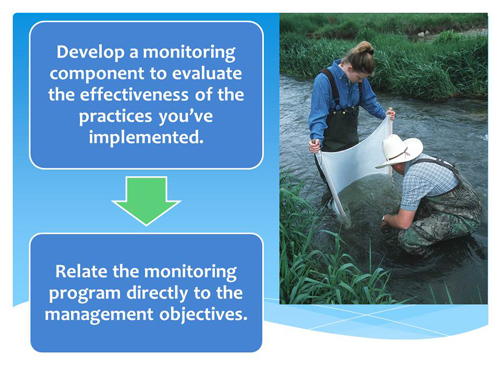Step 4: Design Implementation Program and Assemble the Watershed Plan (cont.)
Developing a Monitoring Component
As part of developing your watershed plan, you should develop a monitoring component to track and evaluate the effectiveness of your implementation efforts using the criteria developed in the previous section. Monitoring programs can be designed to track progress in meeting load reduction goals and attaining water quality standards, but there are significant challenges to overcome, such as communication problems and selecting monitoring designs, sites, parameters, and sampling frequencies.
Measurable progress is critical to ensuring continued support of watershed projects, and progress is best demonstrated with the use of monitoring data that accurately reflect water quality conditions relevant to the identified problems. Monitoring can be done at numerous levels; the most important criterion is that the monitoring component should be designed in concert with your objectives. If another agency is already conducting monitoring (e.g., making annual measurements of phosphorus loads or regulating shellfish beds based on bacteria counts), you might be able to use such ongoing monitoring to track your project’s progress.
Regardless of the specific objective, keep in mind that measures of progress toward your water quality goals are important. Because of natural variability, one of the challenges in water quality monitoring is to be able to demonstrate a link between the implementation of management measures and water quality improvements. To facilitate being able to make this connection, the following elements should be considered when developing a monitoring program.
- Directly relate monitoring efforts to the management objectives.
- Incorporate previous sampling designs.
- Monitor land use changes in conjunction with water quality monitoring.
- Use an appropriate experimental design.
- Conduct monitoring for several years before and after implementation.
- Build in an evaluation process.
![[logo] US EPA](https://www.epa.gov/epafiles/images/logo_epaseal.gif)






